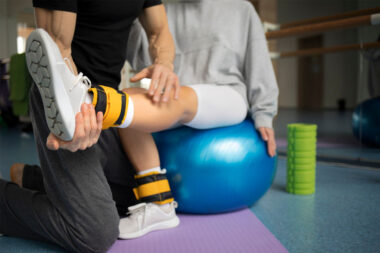For patients who suffer from back pain and discomfort, chiropractors use a variety of instruments and techniques.
The cervical traction device such as neck stretchers is one of the most common chiropractic tools. Cervical traction is an easy, quick way to treat neck pain. It can be performed in the office by your healthcare provider or physical therapist, or you can do it at home yourself.
It has been proven that cervical traction relieves pressure and pain by stretching out the vertebrae and muscles. Furthermore, it has been reported that most patients experienced significant pain relief immediately following treatment. It increases blood flow to the head and neck by stretching and relaxing the muscles and joints around the neck.
What is Neck Traction or Cervical Traction?

When you have neck pain, it is common to use neck traction, also known as cervical traction.
As a treatment for neck pain, cervical traction involves gently pulling the head to create space between the cervical vertebrae. Often, it is also called as spinal traction.
If you want to perform cervical traction at home, you can do it on your own or ask a healthcare professional to help you. You can use a neck relaxer or do it manually (by hand).
In any case, cervical traction reduces pressure and tension in your neck by creating additional space between your vertebrae. As a result of its use, people can experience relief from symptoms such as pain and discomfort related to a variety of conditions.
Through the separation or pulling of vertebrae, cervical traction devices ease pressure on the spine. In addition to being highly effective, it is also fast-acting. If you want to help yourself with neck pain through cervical traction therapy, you should also include exercises and posture corrections in your program.
How Neck Stretcher can help in curing Cervical Traction?
Disc degeneration, herniated or bulging discs in the neck, arthritis, radiculopathy, and muscle spasms are some of the conditions treated with cervical spinal traction.
In cervical traction, the head is gently pulled away from the neck, which helps reduce pinched or compressed nerves by expanding the space between vertebrae.
- In addition to treating neck pain, tension, and tightness, cervical traction devices are used to treat a variety of conditions.
- Relaxation of the muscles and increased flexibility can be achieved by cervical traction, thereby relieving pain and stiffness.
- As the vertebrae and muscles of the spinal column are stretched, tension is relieved and pain is reduced. The head is pulled away from the neck using force or tension. The muscles can relax when space is created between the vertebrae. In this way, the neck muscles and joints are stretched or lengthened.
Temporary conditions can also be treated with cervical traction, including:
- Radiculopathy or other pinched nerves.
- Neck sprains.
- Cervical disc
- Cervical spine fracture
- Facet joint dislocation
- Atlantoaxial subluxation
- Occipitocervical synopsis
- Spondylosis
- Fractured spine.
During the acute phase of traumatic injury or gross inflammation, cervical neck stretchers are also used to treat acute spine infections, e.g., meningitis, and arachnoids, as well as spinal cancer (traction may increase metastases or promote instability) and infections of the spine and bones.
How do you use a cervical neck stretcher?
- In many medical supply stores, you can find over-the-door traction units for use at home for neck traction, or you can order online from the website – Pain Free Aussies.
- It is important that you consult your physical therapist prior to buying a device to ensure you are using it properly and that you are using the right amount of force appropriate to your condition.
- There are smaller traction units that mimic the devices used in physical therapy clinics that can be used at home if you benefit from mechanical traction.
- It is less expensive and easier to use, as well as less cumbersome. When a mechanical traction unit is felt to be beneficial for you, your physical therapist can assist you in receiving it.
- If you use a neck traction device, you should avoid applying too much pressure to any area of your head, such as your ears, jaw, or sensitive back of your skull, since uneven forces can lead to discomfort, and you may not apply enough decompression force to achieve your desired outcome.
How often should you use a neck stretcher?
It is recommended that cervical traction be performed twice a week, once or twice a day, for a few minutes, or for 20 to 30 minutes. For each session of over-the-door traction, you should give yourself 15 to 20 minutes. There is no limit to the number of sessions you can perform per day.
During the use of over-the-door traction devices, you should consult your doctor if your pain increases. It is possible to sit upright in a chair while using some traction devices. In order to overcome the effects of gravity, these devices require much higher force loads.
How long should you use a neck stretcher?
Forces will vary depending on body positioning and body size. When performing cervical traction, it is often preferable to lay on your back in order to achieve the desired results with less force. The most effective treatment for acute neck pain may consist of one to three episodes per day, lasting about 10 to 15 minutes each. For best results, use a force of 10 to 20 pounds. Some people tend to follow DIY approach by using neck pain relief devices.
The traction forces should be lowed at the beginning and raised during the middle and end of the treatment on most patients. In the first 4 minutes, apply 10 to 12 pounds of force, then gradually increase the pressure to 14 to 18 pounds for 10 minutes, and then reduce the pressure to 10 to 12 pounds for the remainder of the exercise.
Conclusion
In addition to treating neck pain, cervical traction is effective in treating arthritic conditions and disc bulges and herniation. Every individual’s problems and needs are different, and the treatment you receive should be tailored to suit your individual needs.
If you are thinking about starting a treatment, talk to your doctor or physical therapist first. Throughout your therapy, make sure to communicate with them about your progress and any side effects you experience. In addition, they can assist you in determining what treatment plan you need.
Thumbnail Credit: wayhomestudio
This article is published by our independent team of health and wellness pundits that publish original and informative content to empower readers to take charge of their health and embark on a physically, mentally, and emotionally balanced lifestyle.







































Leave a Reply